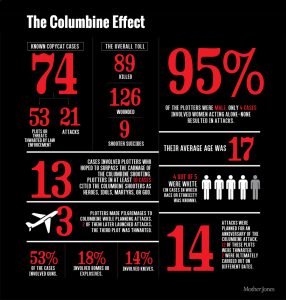Response
One significant aspect regarding events of gun violence that is significant is the response to the events. It can be clearly seen that acts of gun violence are spectacle disasters. However, that line of spectacle versus slow disaster becomes blurred as a result of the lack of inaction and change that occurs at a governmental policy level. How people respond to disaster is what greatly in part serves to shape its history, and this response can help to distinguish between slow and spectacle. With Columbine, 15 people died, including perpetrators Klebold and Harris. According to a survey done by The Pew Charitable Trust, Columbine became one of the most closely followed news stories of the decade, illustrating the continued prevalence Columbine has had in American pop culture.
The Columbine Effect
The Columbine Effect refers to the lasting legacy and impact of the 1999 shooting, including various copycat crimes and allusions to Klebold and Harris. Since 1999, Columbine has inspired 74 known copycat cases, in which 95% of the cases involved male plotters, according to the ‘Mother Jones’ graphic. Such gender differences in the statistic suggest the greater prevalence of violence among men compared to women, specifically younger men, as the average age indicated by the graphic was 17. Further, the graphic illustrates how there have been 89 killed, 126 wounded and 9 shooter suicides, all dead due to the lasting legacy of Columbine. In these cases, the plotters cited Klebold and Harris as “heroes, idols, martyrs or god”, suggesting there was underlying mental illness among the plotters.

(graphic courtesy of Mother Jones)
Columbine has indirectly taken more lives than any other act of gun violence in American history, suggesting that its original impact as a spectacle event led to the disaster’s effects to trickle down to create further spectacle disasters. The aspect of slow violence involved is what happens between each shooting: the lack of action at the hands of the government and the lack of awareness for what the Columbine Effect even is. Following Columbine, the only action the senate took was creating a National Commission on Character Development, and reviewed a new crime bill.
Though they additionally attempted to pass a gun control bill imposing restrictions on gun show firearm sales, it failed to pass. Following the various copycat acts, there was no government action or attempts at passing policy. This is significant as the copy cat acts are arguably a more pressing issue, demonstrating that the events of Columbine are continually resurfacing. This reflects the nationwide ignorance of The Columbine Effect, showing that though the shootings themselves are spectacle disasters, the knowledge surrounding them and their effects can be recognized as a form of slow violence.
Virginia Tech Shooting
One notable copycat act that is categorized as a part of the Columbine Effect is the Virginia Tech shooting that took place on April 16, 2007. 32 were killed and 17 were wounded, with perpetrator Seung-Hui Cho comitting suicide in the end. At the time, this was the deadliest shooting in American history. Cho, a senior at the school, had a history of mental illness, being schizophrenic and had spent time in a psychiatric hospital as his roommate reportedly feared he was suicidal. Cho was then diagnosed with a mood disorder, and was ordered to undergo outpatient treatment.

Students gathered for a candle light vigil. (Win McNamee/Getty Images)
On the morning of the shooting, Cho mailed a package to NBC news, containing a manifesto, photos of him holding weapons, and a DVD with videos of him. Upon examining the videos further, law enforcement officials determined he had discussed “martyrs like Eric and Dylan”, the perpetrators of the Columbine shooting. This suggests Cho’s admiration of Klebold and Harris, and the similarity in date to Columbine’s raises the question of if Cho intended for the shooting to be so close to the eight year anniversary of it. As Cho additionally suffered from mental illness as Klebold and Harris did, it suggests the role mental illness could play in the Columbine Effect, and how it may increase the likelihood of one being “inspired” by the events of Columbine, and choosing to act on it.
Conclusion
It is clear that mental illness and mental health plays a role in the Columbine Effect, but adds further complexity to the blurring of slow versus spectacle in gun violence- Is mental health another manifestation of slow violence? How does the role of mental illness exacerbate the events of human-caused disaster- in this case school shootings?